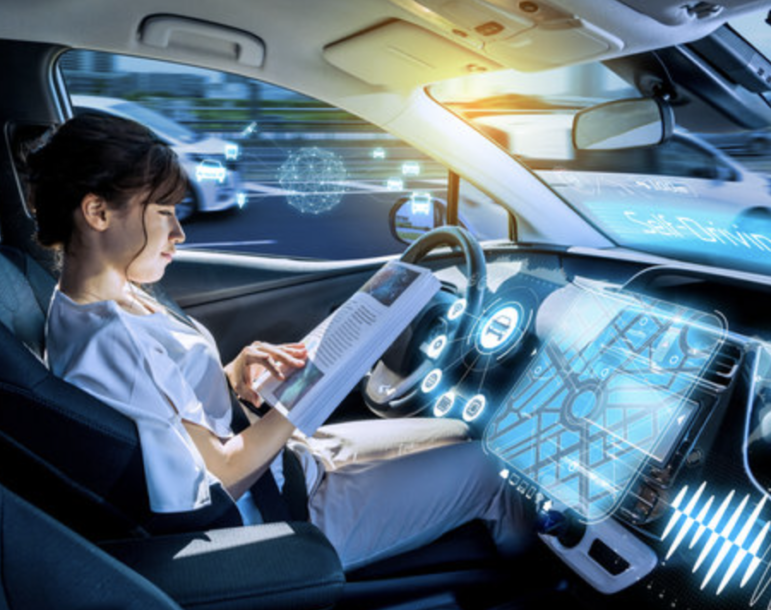Fully autonomous (self-driving) cars may seem like something from the future, but the future is getting closer every day. Many car manufacturers have already implemented several self-driving features and getting to a fully automated car is almost imminent.
Although official production has not yet started, complete self-driving cars could reach the market in the coming years.
It is difficult to imagine a world with cars without a person behind the wheel and this raises many questions and concerns. Will self-driving cars be safe? How expensive will they be? But most importantly, who is responsible in case of an accident?
According to investigations by independent media, such as The Ferenstein Wire, this new technology could reduce the risk of car accidents and therefore significantly lower the cost of car insurance, but questions remain.
Current issues with self-driving features
Beyond the futuristic appeal of self-driving cars, dozens of automakers have released automated components in recent years, including features that allow you to take your hands off the wheel under certain conditions and that help you parallel park.
An advanced driver assistance system can steer, brake, and accelerate vehicles on its own, although drivers must remain alert and ready to take control of the vehicle at any time.
Safety experts are concerned that these systems allow drivers to relinquish active control of their cars and could lead them to believe that they are driving their cars themselves. When technology malfunctions or can’t handle a particular situation, drivers may not be ready to take control quickly.
Some independent studies have explored these technologies but have not yet shown whether they reduce accidents or improve safety.
In November 2022, Tesla recalled nearly 12,000 vehicles that were part of the beta test of Full Self Driving, a version of Autopilot designed for use on city streets, after rolling out a software update that the company said could cause accidents due to unexpected activation of cars.
The NHTSA required companies to provide crash data when advanced driver assistance systems and automated technologies were in use within 30 seconds of impact. Although this data provides a broader picture of the behavior of these systems than ever before, it is still difficult to determine whether they reduce accidents or improve safety.
The agency has not collected data that would allow investigators to easily determine whether using these systems is safer than turning them off in the same situations.
The landscape of autonomous cars
Fully autonomous cars are yet to be sold to the public. However, automated driving systems are already present in some vehicles and tests are being carried out every day.
Currently, many of the major automakers are working to make autonomous vehicles a reality and testing the technology to advance their production.
Although driverless vehicles are not yet a reality, self-driving technology is advancing rapidly.
To illustrate where the advancement of this technology is currently, the National Highway Traffic Safety Administration (NHTSA) has described the different levels of automation of the Society of Automotive Engineers. Currently, this technology is at level 2.
These are the levels of automation:
0 = No automation, where the driver is fully responsible for driving.
1 = Driver assistance, where some features help you drive.
2 = Partial automation, which includes automated functions such as steering and throttle, but the driver remains responsible and must be present and attentive at all times.
3 = Conditional automation, in which the driver is necessary, but is not in charge of supervising the environment, although he must be prepared to take command when necessary.
4 = High automation, where the vehicle can take over all driving under certain conditions, and the driver can take control when needed.
5 = Full automation, where the vehicle can take over all driving in all conditions, and the driver can take control when needed.
Although more and more manufacturers are incorporating self-driving functions into their cars, a vehicle is still a few years away from being fully autonomous. The NHTSA predicts that by 2025, or slightly later, fully automated security features are likely to be available and on the market.
Currently, General Motors aims to build one million autonomous cars by 2030.
Who is responsible for an accident with an autonomous car?
One of the main questions that exist with autonomous cars is whether it will still be necessary to buy car insurance.
Insurance companies normally assess a driver’s risk on the road, among other factors, and offer various types of coverage in case of property damage, bodily injury, etc.
In many cases, accidents are caused by the fault of the driver. So, what happens if the driver is no longer needed, and the risk is greatly reduced? Will the accident that happens be the fault of the driver or the manufacturer of the car?
In response to these questions, the NHTSA states:
“It is vital to underline that drivers will continue to share driving responsibilities for the foreseeable future and must remain attentive to the task of driving and to the road with today’s available consumer technologies. However, liability and insurance issues are some of the most important, in addition to technical considerations that are being worked out before automated driving systems reach maturity and are available to the public.”
What does the future hold for autonomous cars and liability?
Although autonomous cars may reduce the risk of an accident, car insurance will still be necessary.
According to the Insurance Information Institute of America, claims around accidents may be reduced, but coverage will still be needed for property damage, injury, or loss due to theft or acts of nature.
There is no doubt that at some point autonomous cars will be a reality and insurers must prepare for it.
One of the lingering questions is who will pay in the event of an accident. Although NHTSA claims the responsibility will be shared, it will need to be clarified how it would work. Will the insurance company have to fight with the manufacturer of the autonomous vehicle if the technology has failed and the driver was not at fault?
In the coming years, auto insurance will have to evolve and adapt to the arrival of autonomous cars.
Auto insurance for autonomous vehicles could be different than what we are used to today. Insurance companies will have to have the flexibility to adapt their policies and offer adequate coverage and service for the era of autonomous cars.
How can PMR Law help?
If you or someone you love has been involved in an accident due to someone else’s negligence, contact one of our car accident attorneys. Contact us today to schedule your free consultation and discuss your legal rights. We care and we can help.
Contact a Local Lawyer
Get in touch with us so we can evaluate your case for free. Call PMR Law at 832-844-6428 and a member of our team will get in touch with you immediately.
PMR Law is considered one of the Best Law Firms in America, by Rue Ratings. Several of our attorneys have been given the honor of being named Super Lawyers by Thomson Reuters. The American Institute of Personal Injury Attorneys has named our attorneys 10 Best in Client Satisfaction. Speaking of personal injury, Attorney and Practice Magazine awarded our attorneys with Top 10 Personal Injury Attorney distinctions. The National Trial Lawyers have named three of our attorneys as Top 100 attorneys. The Academy of Attorneys has named two of our attorneys as Top 40 Under 40. Our attorneys have been recognized as Best Attorneys of America, by Rue Ratings. PMR Law is a proud member of the Multi-Million Dollar Advocate Forum. Houstonia Magazine has named two of our attorneys as Top Lawyers in Personal Injury.
Texas Lawyer magazine has named PMR Law as the #1 Personal Injury Law Firm in Houston.

